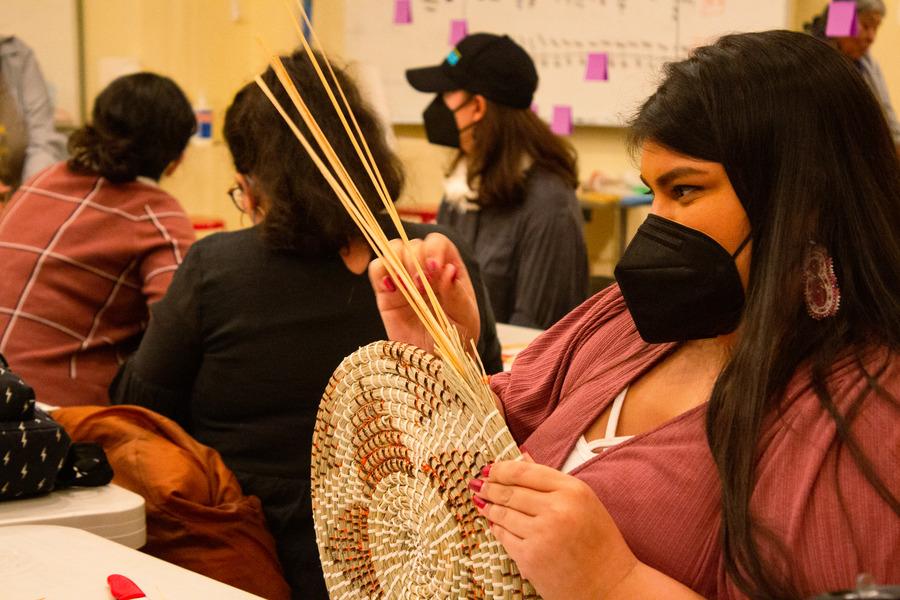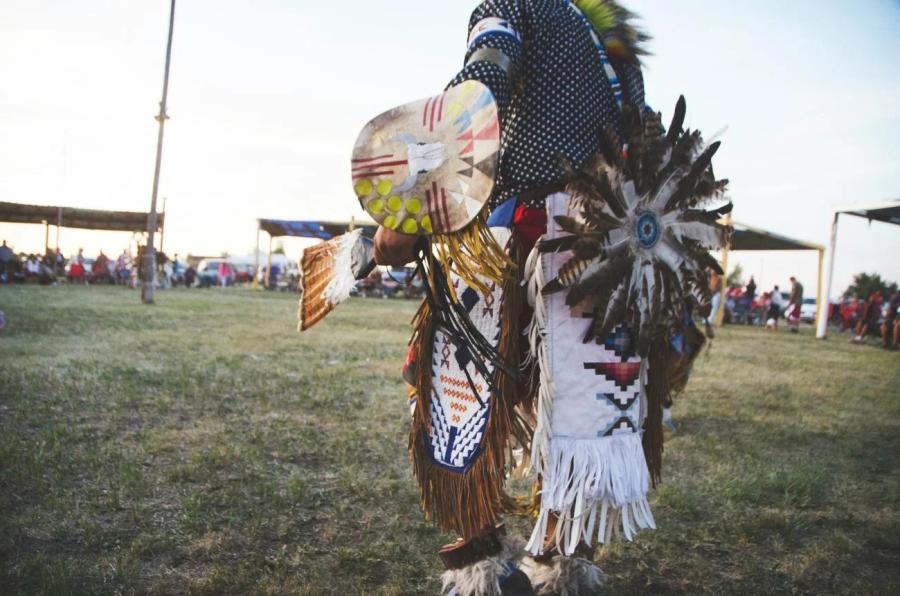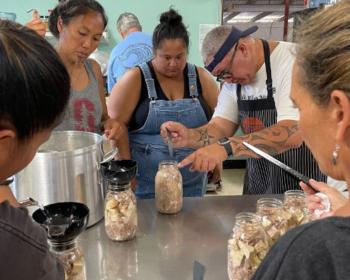I was born in the territory of Alaska on July 9, 1950, in the Inupiat community of Unalakleet, on the eastern coast of Norton Sound, Alaska. My parents are Irene Pan’niuq (nee Koutchak) and Stanton Talialuk Katchatag.
“Unalakleet” is the anglicized version of the Inupiaq name for Ungalaqliq, “the place where the winds blow constantly.” Local residents say Unalakleet's Inupiaq residents mostly descend from a family of five brothers and one sister; according to anthropologists the community was established 1,500 years ago, occupying two nearby sites before settling into its present location.
My earliest memories of Unalakleet begin when I was around six. My family, which had moved to Anchorage soon after I was born, went back home in 1956. My father was a subsistence hunter and fisher who also served as a member of the village council. My mother was a homemaker who also worked as a volunteer health aide, and she was also an accomplished hunter (I have a portrait of her taken in 1993, at the age of 70, with a caribou she has just shot).
Alaska officially became a part of the United States on January 2, 1959. The federal legislation that enabled Alaska statehood, however, had been adopted by Congress on July 7, 1958. As the news spread throughout rural Alaska’s Native villages, I think most of our people did not recognize the legal and political implications of statehood for us. In fact, I was a woman of 34 before I learned that Alaska’s Inupiat villages (such as Unalakleet) had tribal status, and that our people were commonly referred to in federal law as Indians, along with the indigenous Athabascans, Tlingit, Haida, and Tshimpshian Indian villages of southeast Alaska.
On December 18, 1971, when Congress passed the Alaska Native Claims Settlement Act (ANCSA), I was a young housewife living in Chicago, Illinois. Land claims and such issues were the furthest things from my mind. Some time in early 1972, I saw a full-page advertisement in the Sunday editions of both the Chicago Sun-Times and Chicago Tribune newspapers. The ad copy read in giant type, “Are You An Alaska Native?” The small type said somebody had important news for us, and invited us to attend a citywide meeting.
I recall being a little bemused when I found out at the meeting that I was the owner of 100 brand-new shares of Native corporate stock. As part of the enrollment process, I was asked my place of birth; when I replied, “Unalakleet,” the enrollment officer began completing a form that would have made me a shareholder of the Bering Strait Native Corporation. I quickly added, “But when I go back to Alaska, I’m going to live in Anchorage.” The officer sighed, tore up the first form and enrolled me in Cook Inlet Region, Inc. (CIRI).
I returned to live in Alaska in April 1974. As a mother (and soon a divorcée), my main interest was to make an independent living. I worked briefly for the federal Office of Environmental Health, which employed members of the Corps of Engineers to build water and sewer projects in Native villages throughout Alaska. Later I worked for the Alyeska Pipeline Service Company and Sohio Construction Company.
Aside from information contained in CIRI’s shareholder newsletters, I knew next to nothing about the legal and political issues facing our people. I possessed only the most general knowledge of the subsistence issue when I took a job in April 1982 in Unalakleet as a research assistant for the John Muir Institute. The institute had obtained a contract with the Minerals Management Service to investigate what impacts some proposed petroleum site leases might have on subsistence-reliant communities in the Norton Sound area.
I first heard the term “tribal sovereignty” in February 1984, on the first day of the first roundtable discussion conducted by Thomas Berger for the Alaska Native Review Commission.2 John Borbridge, a former president of the Central Council of Tlingit and Haida Tribes of Alaska (and an early president of the Sealaska Corporation), said one of the main goals that Natives had in pressing their land claims was to retain their identity as tribes.
“Sovereignty, I firmly believe, is an outgrowth of this powerful aspiration,” Borbridge said. “In my opinion, too much technically has been made of [the question], ‘What does sovereignty mean?’… It is the power to act as a tribe, the power that comes from being a tribe.”
Leaders from other Alaska tribal cultures also spoke to the review commission about tribal sovereignty in the context of the Alaska Native land claims initiative. Don Wright, an Athabaskan leader who was president of the Alaska Federation of Natives3 when ANCSA was passed by Congress, told the review commission:
I think it’s important to note that we were under tremendous threat and stress during the time of [the ANCSA] hearings. There was no money to go into the villages and get the real testimony from the real people, the grassroots people. The only opportunity we had was to attempt to reflect the feelings of the real people as leaders [who were] under the threat of possibly going to jail, of possibly being punished economically, socially. We testified in many instances under instructions from attorneys, church leaders, [Bureau of Indian Affairs] personnel, state personnel, the state attorney general’s office, the governor’s office. We were instructed that to really say what we thought would probably stop everything.
I feel that as we moved forward with ANCSA we knew of sovereignty. We knew of integrity and tradition and Native religion (not Christianity); we knew of all these things. We were motivated mostly by attempting to defend ourselves to the best of our ability, and not lose everything. We attempted to satisfy the tribal organizations … that felt the real sovereign meaning of land and control and ownership (and some of those claims overlapped one another). So we had to attempt to resolve those disputes without focusing [outside] attention on that attempt. The evolution of the village and regional corporation … was a unified attempt to defend against the “intruder,” the “trespasser.”
Wright starkly outlined the nature of the “threats” faced by Native leaders in taking their desire for a just land claims settlement to Congress in the 1960s:
The first bills that were introduced by Rogers C.B. Morton represented the [presidential] administration; they introduced a bill for a million acres of land and a $100 million settlement. We were put in a position where we had to do something drastic and we even threatened war, bloodshed, feeling it would be the only way we could get them to focus on the real issue of sovereignty, the fact that the Native people had their own law and they owned the land. And we were advised by [Lower-48 tribes] on many occasions to totally reject the corporate concept and maintain strictly a tribal concept.
But [Senator Henry] Jackson and [Congressman Wayne] Aspinall4 said that we could die with nothing if we didn’t straighten up. We were told that by [representatives of] major oil, timber, and mining companies, even people from the Chambers of Commerce; they said, “You will take what you get, and be thankful for it.”
Berger ultimately conducted eight roundtable discussions on topics that included U.S. national policy toward its indigenous communities, including those in Alaska; the potential economic, social, and cultural impacts of proposed changes to ANCSA affecting shareholder rights and the alienability of Native corporate lands; subsistence hunting and fishing rights; and how other countries had dealt with or were dealing with aboriginal peoples’ land claims.
Each roundtable discussion lasted from two to four days, each proceeding from 9 a.m. to 5 p.m. The roundtable participants covered a world of expertise in federal Indian law, Alaska Native history and politics, state and federal history and policies affecting Alaska and Lower-48 tribes, and even philosophers well known for their works on the various effects of contact and relations between aboriginal groups and non-Native governments. As an observer from the first roundtable to the last, at the end of 1984, I progressed from almost total ignorance about tribal sovereignty in Alaska and elsewhere to receiving an education from professors, policy-makers, tribal leaders, and Native historians which may be unattainable in formal educational processes today.
The Roundtable Process
When done right—and Berger not only did it right, he invented the process—a roundtable discussion becomes more than a formal proceeding. As participants become comfortable with each other, an almost alchemic happening occurs: first, they begin conversing rather than declaiming; second, and best of all for the audience, the participants begin to agree, to disagree, and to supplement each others’ insights or opinions. When that happens, the audience is treated to a bounty of information that is all the more valuable because it is extemporaneous.
The roundtable discussions were conducted in the Rondy Palace in Anchorage, a setting that, when the roundtable materials were put away, became a bingo hall at night. As news about the discussions spread through the Native community, the audience grew from perhaps a dozen or so people to a full house every day.
Near the Rondy Palace a whitewashed Catholic church with a somewhat California air still stands. The church had a carillon that tolled the quarter-hours. So rapt was I in listening to the conversations, so fascinating were the arguments, so often heated (though polite) were the disagreements, so compelling were the accounts, that at times the church bells would sound as if they were across town instead of across the street. I would push back my sleeve to look at my watch and discover that several hours had passed since I last checked the time.
In addition to conducting the roundtables, Berger was invited to more than 60 Native villages. Through such visits, his investigation of the impacts of ANCSA expanded to include cultures other than those of the Yup’it and Inupiat. He traveled to southeast Alaska and took testimony from the Tlingit, Haida, and Tshimshian peoples. He traveled to the interior of Alaska to hear from the many Athabascan tribes along the Yukon, Kuskokwim, Koyukuk, and other rivers. He also visited several Aleut villages.
In December 1985, Berger published his findings in the book Village Journey5: Many Americans believe that to claim rights for tribes, classes, groups or collectives, runs against the American individualist tradition. They consider that the protection of individual rights is the most effective way to secure such interests. Legal and constitutional means to protect these rights for minorities in the United States are expressed in laws to prevent discrimination on the basis of race, nationality or color, and in laws to protect the free exercise of religion. Although Native Americans from time to time claim the benefit of these laws, their central concerns do not fall within these categories.
Native rights rest on a fundamentally different footing from the claims of black Americans and immigrant minorities,” writes Berger. “Their attempts to preserve, on their own terms and for their own purposes, a land-based culture and way of life mark Native Americans off from other minorities. No other minority can assert a right to a land base and to distinct political institutions founded on the recognition of Native sovereignty.
Berger recommended that Alaska tribal governments “assert their Native sovereignty.”6 Since that time, Alaska’s tribes have organized on a statewide basis;7 have seen their governments formally recognized by the United States8; have participated in government-to-government talks with the State of Alaska in order to reach accord with the April 11, 2001, Millennium Agreement9; and have witnessed several strong rulings by the Alaska Supreme Court that affirm tribal court jurisdiction over child custody and welfare matters.10
Two disparate sources demonstrate the value of this tribal sovereignty to Alaska Natives: “What it really was all about…is that many Native people have transferred all of their hopes and all of their aspirations and all of their frustrations and all of their anger to ANCSA, for reasons that we all can understand as it exists in human nature,” said Tlingit leader Byron Mallott at the Februrary 29, 1984, Spirit of ANCSA Roundtable Discussion. “But we’re ignoring and are not focusing our efforts and energies on those outside institutions in government and elsewhere that have as great an obligation to work with us, to get where we want to go. … And you cannot bring us the solutions … ultimately, we are the ones to deal with [our problems and resolve them].”
Inupiaq Mary Miller of Nome, who participated in the December 13, 1984 Alternate Approaches to Native Land & Governance Roundtable Discussion had a different view: In 1983 I bravely (or naively, as the case may be) made an effort to write about our peoples’ future. I tried to take a perspective of just the average person at the local level … to look at what options Alaska Natives were looking at for protecting their land in the future, then evaluate these options as to their legal, economic, and cultural feasibility. Since then, having worked … with tribal governments in the Bering Strait region, I believe that my views have become much more in favor of at least exploring the feasibility of utilizing our tribal governments. … What we are looking at in our region now is to form some kind of regional consortium. In doing that, we would delegate no governmental authority from the villages to a regional group, whatsoever. It would just be mainly to have a collective voice in addressing issues.
Currently we have three villages that are contracting for services themselves. This has taken away from Kawerak contracting for federal services from the Bureau of Indian Affairs. We foresee that probably more villages will be doing the same thing and I can proudly state that the administration of our tribal nonprofit is open to that idea.
1. All quotations from roundtable discussions used in this article are from the proceedings’ transcripts.
2. Berger, T.R. (1986). Village Journey. New York: Hill & Wang Publishers. In July 1983, Berger was appointed by the Inuit Circumpolar Conference [ICC] “to review the Alaska Native Claims Settlement Act [ANCSA] of 1971.” The ICC asked Berger (a Canadian attorney and former member of the British Columbia Supreme Court) to investigate the impacts of ANCSA on the Inupiat, Central Yupiit and Siberian Yupiit of Alaska. Berger invited Alaska Native leaders, representatives of the State of Alaska, and staff to congressional leaders to discuss the development and adoption of ANCSA by Congress. The roundtable format enabled participants to question each other, add their own perspectives and submit their own opinions as part of wide-ranging conversations that were conducted in front of a non-participatory audience. The World Council of Indigenous Peoples (an arm of the United Nations) was a co-sponsor of the commission’s work.
3. The Alaska Federation of Natives was established in 1966 as an organization of Alaska Native leaders who shared the work of pushing for Native rights as the land claims legislation moved through Congress in the 1960s and early 1970s.
4. Senator Henry “Scoop” Jackson chaired the Interior Committee that had primary jurisdiction over ANCSA during its debate and passage by Congress; Congressman Wayne Aspinall chaired the counterpart committee in the U.S. House of Representatives during the same period.
5. Berger, T.R. (1986). Pp 156, 157.
6. Berger, T.R. (1986). P 170.
7. The United Tribes of Alaska was organized in 1982 but only lasted through 1985; the Alaska Native Coalition was likewise short-lived, lasting only a couple of years in the late 1980s. The Alaska Inter-Tribal Council (AI-TC) was established in 1993 as a statewide tribal advocacy organization. Though often beset with problems related to lack of adequate financial resources (and some lack of political support within the Alaska Native community), AI-TC has survived to this day, much longer than its previous counterparts.
8. In October 1993, then Assistant Secretary for the Bureau of Indian Affairs Ada Deer (herself a member of the Menominee Tribe of Wisconsin) published a list of 225 federally recognized tribes in the Federal Register. Since that time, four more entities have been added to the list. The 1993 Federal Register notice preamble clarified the history of federal, territorial, and state treatment of Alaska tribes; listed all entities found to be tribes (as of 1993); and reaffirmed that Alaska tribes should possess the same legal and political status, rights, and authorities as tribes elsewhere in the United States. Congress enacted various laws reaffirming the rightness of the 1993 listing.
9. On September 29, 2000, Alaska Governor Tony Knowles issued a formal administrative order (No. 186) which formally acknowledged all of Alaska’s federally recognized tribes. The administrative order established the framework for government-to-government dialogue between Alaska tribal leaders and members of the Knowles administration. Those talks resulted in the signing, on April 10, 2001, of a Commemorative Millennium Agreement “between the federally recognized sovereign tribes of Alaska and the State of Alaska.” The agreement was modeled on the State of Washington’s Centennial Accord, which it reached with tribes of that state toward the end of the 20th century.
10. In the landmark John v. Baker case [982 P2d 738 – Alaska 1999], the Alaska Supreme Court deferred to the federal recognition of Alaska tribes. In their unanimous ruling, the court upheld Alaska tribes’ authority to adjudicate matters of child custody involving tribal members (see page 31 this issue).
Vernita Herdman is the advocacy coordinator for the Rural Alaska Community Action Program in Anchorage.



